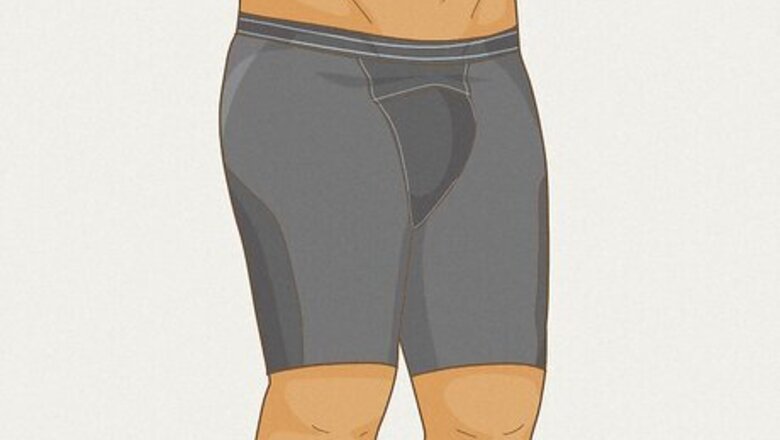
views
Wearing Waist Protection
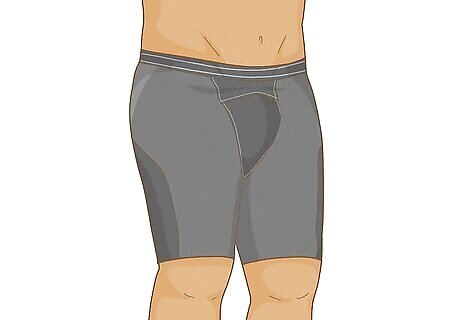
Put on your jock shorts with a sewn-in cup. Many players these days wear jock shorts, also known as jill shorts for female players. It’s basically spandex boxer shorts with a built-in cup as well as velcro pads to attach your socks. Step into the shorts and slide them up to your waist, checking that they feel snug but not restrictive. Also, position the cup securely on your front end, over your groin, before continuing. Jock shorts and jill shorts are cut differently so they fit differently. Make sure you get the kind you need. Jock shorts are for the guys and jill shorts are for the ladies. Make sure the cup stays in place between your leg. If it feels loose, it will probably chafe your legs or fall out of place while you’re playing. Stay safe by getting the right fit! You do not have to wear anything underneath a good pair of jock shorts. If you want to, you could wear normal underwear or a tight pair of shorts such as track shorts. It depends on how comfortable you feel and how well the jock shorts fit.
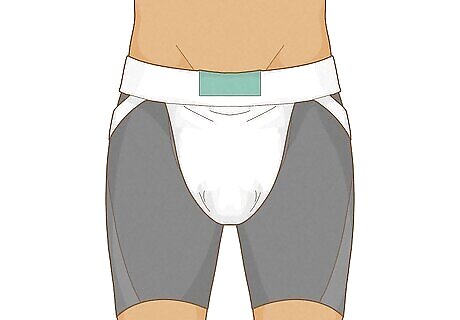
Wear a cup over compression shorts if you prefer traditional equipment. Some players don’t like jock shorts, so they choose a separate cup. When you’re going the old-fashioned route, put on a form-fitting pair of shorts first. Then, slide the cup into the shorts, positioning it to cover your groin. Make sure it stays in place as you move. Women use a piece of equipment called a pelvic protector. It works the same way as a cup for men except you put it on underneath your shorts. Compression shorts are like bicycle shorts. They are meant to fit tightly against your body while absorbing sweat as you play.
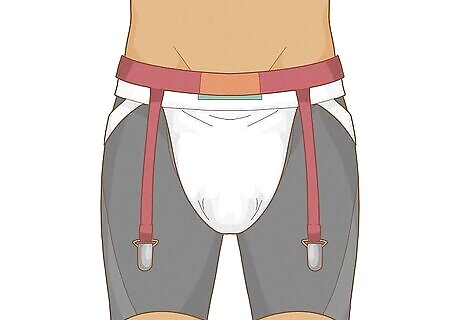
Place a garter belt around your waist if you need to secure your socks. Garter belts are basically elastic bands with hanging buckles that clip to your socks. Step through the belt and pull it up to your waist to put in on. This will leave you with a buckle on the front and back of each of your thighs. This is one of the simplest pieces of equipment to put on, and you don’t even need it if you’re using jock shorts. Most hockey jock shorts have built-in velcro hooks for your socks.
Padding and Completing Your Lower Body
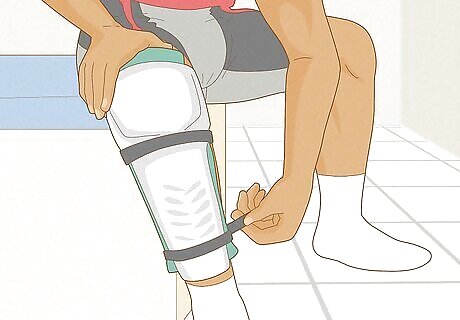
Place your shin guards on top of your legs. Sit down and stretch your legs out ahead of you. Each shin guard has a round cup on top for your knee. The rest of the shin guard stretches out down to the tops of your skates, which you put on later. When you’re ready to secure the shin guards, bring the velcro bands back and connect them behind your legs. Goalies have special leg pads. If you’re a goalie, put on your shin guards and your hockey socks, then tie the pads to your legs. The pads have bands that tie around your legs and skates.
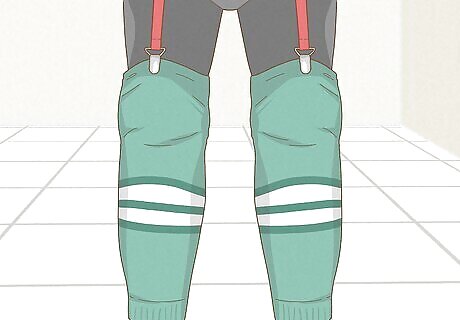
Slide ice hockey socks over the shin guards. Put your toes through the socks and pull the fabric up toward your knee. Focus on covering the bottom edges of the shin guards tightly before pulling the socks all the way up toward your jock shorts. If you’re wearing jock shorts with velcro tabs, hook the socks to the tabs to hold them in place over your legs. If you’re wearing a garter belt, use the clips to hold the socks up. You have 2 clips for the front of your thighs and 2 for the back. Press the open ends of the clips to clamp them to the socks. If the socks feel loose while you’re wearing them, hold them in place with clear hockey tape. Wrap the tape around your leg right underneath your kneecaps. This will also pin down loose shin guards. You could wear regular socks underneath hockey socks to cover your feet. Use whatever socks you wore to the dressing room. Some players like doing this to keep their skates free of sweat, but others find it uncomfortable.
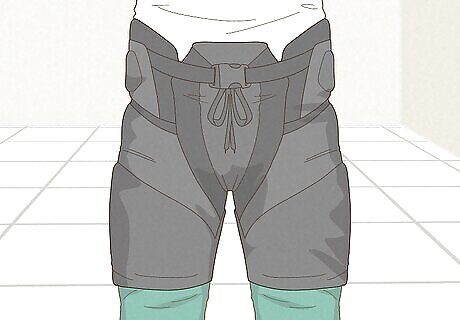
Pull a pair of hockey pants up to your waist. You’re finally ready to add the final layer of padding to your lower body. Hockey pants have pads all over, so position them in the correct spots. When you’re ready to secure your pants, tie the strings on the built-in belt. Pull the belt so it is tight against your waist without making you uncomfortable. In particular, pay attention to the tailbone pad on the back side of your pants. It needs to pad the area right over your butt. Tailbone injuries are more painful than you expect and you don’t have any other padding there. Like a lot of other equipment, hockey pants come in many different sizes. Getting the correct size is important for your safety. The pants need to fit well over your waist while being short enough to avoid covering your knees.
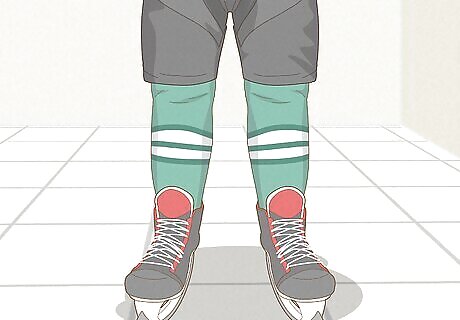
Put on and lace up your skates. Skates are one of the biggest factors in both playing your best and staying safe, so take all the time you need to put them on. As you push your feet in, kick your heels back. The bottom of your shin guards will be right above the tongue of your skates when everything is in the proper place. For safety, tie the top skate laces as tight as you can, then tie the bottom ones according to how loose you like your skates. While you can wait to put on your skates, it’s best to do it now unless someone else is going to tie the laces for you. The upper pads used in hockey make bending over tricky. Plus, putting them on now gives you plenty of time to test out the fit. Well-tied skates support your ankles, which is why the top laces are so important, especially for younger players. You can adjust the other laces. Some players prefer tight skates while others do better with looser fits. Check where your toes are at in the skates. Rest your heels on the heel pads so your toes barely touch the front of the skate. If you aren’t able to do this, your skates are the wrong size for your feet. Get up and walk around on your skates for about 15 minutes to see how they feel. Give them a thorough testing and make any adjustments needed before you go out on the ice.
Adding the Upper-Body Padding
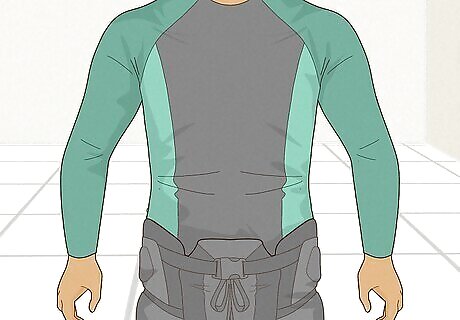
Wear a compression shirt or T-shirt underneath your gear. A compression shirt is a great choice for your base layer. It’s a tight shirt that clings to your body while wicking away sweat. If you don’t have one, an old T-shirt works, but try to get one that fits you well. If it’s long and loose, it’s going to get in the way while you skate. If you’re familiar with compression shorts, then you have an idea of what a compression shirt is like. These shirts are a little costly, but they handle sweat better than most T-shirts if you can afford them. Choose a T-shirt that adheres tightly to your body and ends at about your waste. If it’s a little long, you can tuck the excess length into your pants. Use hockey tape if needed to keep it pinned down.
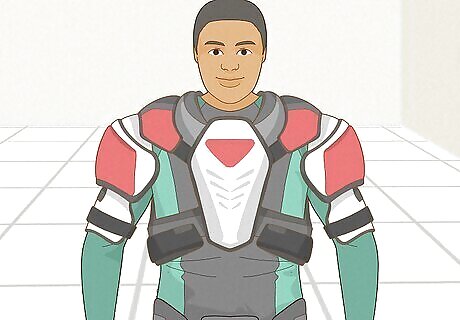
Pull the shoulder pads on over your head. This piece of equipment is a little deceptive since it’s more like a chest protector a catcher would wear than anything else. It has a hole in the top you fit your head through. When you’re in, rest the shoulder caps on top of your shoulders. Finish up by tightening the straps around your upper arms and armpits. The shoulder pad caps are similar to the knee caps on your shin guards. Center them on your shoulders. If they feel loose or uncomfortable, adjust them before moving on to the next piece of equipment. Test the pads by lifting your hands above your head. Make sure you’re able to move freely without the pads digging into your skin. Goalies have extra-thick padding that is put on the same way as regular shoulder pads. Many goalie shoulder and chest pads have elbow pads and neck protectors built in so you don’t need to put on separate ones.
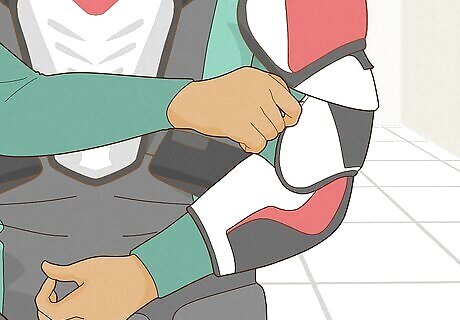
Strap elbow pads over your forearms. Elbow pads aren’t too tough to figure out as long as you remember that the padded side covers your elbow. Hold your arm out and fit your elbow into the cap on the pad. Let your forearm rest on the forearm pad above it. Then, wrap the velcro straps around your arm to secure the pads in place. Keep in mind that there is such a thing as left and right elbow pads. Tell them apart by determining which pad protects the outside edge of your arm. If the pad faces away from your body, it is on the correct arm. Test the fit by flexing your arm a few times. If you can’t move your arm very well, loosen the pads a little. Oversized pads can also limit your movement.
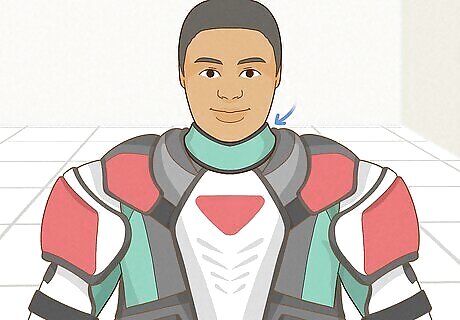
Wrap a neck guard around your neck if your shirt doesn’t have one. Neck guards are kind of like padded bibs that fit over the area underneath your chin. Face the padded part out so the strap is behind your neck. Then, wrap the strap over to pin it to the velcro on the neck band. Tuck the end of the neck guard underneath your shoulder pads to finish putting it on. Some types of compression shirts and athletic underwear have built-in neck guards. It’s no different than a collar on a dress shirt. If you have a built-in neck guard, you don’t need to wear a separate one. Neck guards are becoming more and more common in hockey. Consider getting one even if your league doesn’t require you to. Don’t risk taking a skate to your neck.
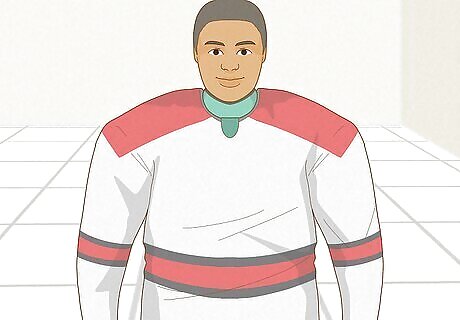
Pull your jersey down over your head. It’s no different than putting on your shoulder pads. Jerseys aren’t there for protection, so focus on the fit. A good jersey is the perfect size to fit comfortably over you without restricting your movements. Most jerseys are a little bigger than they need to be, so tuck the fabric into your pads to hold it in place. If the jersey is too small, it will feel tight and confining against your pads. If it’s too big, it’s like a curtain caught in the wind. It gets in the way and serves as a target for some sneaky defenders to grab onto when the ref isn’t looking.
Putting on Exterior Gear
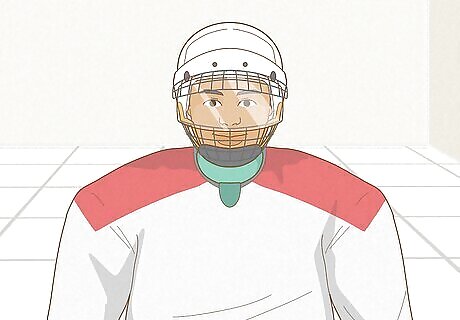
Cover your head with a full-masked hockey helmet. No hockey player is complete without a snug helmet. Hockey helmets have chin straps you buckle after you put the helmet on. Slide the chin guard over your chin, pulling the strap tight enough to leave no more than a finger-width of space between the strap and your body. Then, test the fit by shaking and nodding your head. A good fit comes from buying the right size of helmet. When you shop for equipment, try on different models. Have someone hold a tape measure around your forehead to determine the circumference. Most modern helmets are somewhat adjustable, but don’t let your helmet get too loose. If your head rattles around in there when you move, it’s going to rattle around when you get hit. The protection doesn’t do you any good then. Keep a screwdriver and spare screws in your gear bag. Helmets have small screws all over them that pop out sometimes. Tighten them to tighten the helmet’s fit and replace them as you lose them.

Slide your hockey gloves up to your wrists. Hockey gloves are big, bulky, and cover your wrist and part of your forearm. A good pair reaches your elbow guards but doesn’t overlap them. You don’t have to do anything special to put them on, so be sure to size the gloves before you buy them. Hockey gloves fit like winter gloves and have to be easy for you to open and close in order to control your stick. Choose gloves with extra padding around the thumb to protect yourself from slashes and sprains. If you’re a forward, you might choose gloves with shorter cuffs. This will expose your forearms a little bit, but some people prefer it for flexibility when shooting a puck. Keep in mind that goalies have a catching mitt and a blocking pad instead of regular gloves. There isn’t anything special to keep in mind when putting them on besides that you put on the catching glove first. Slide your opposite wrist through the blocker's strap to keep the blocking pad on the back of your hand.

Pop in a mouthguard that covers your teeth. The easiest way to get a mouthguard is by going to the nearest sporting goods or general store. These places sell plastic mouthguards for general use. If you’re looking for something more form-fitting, speak with your dentist for a custom mouthguard. Custom mouthguards are much more expensive since the dentist needs to shape it to fit your mouth. Getting one is a good idea if you have braces or other things that could prevent you from holding a regular mouthguard in place.
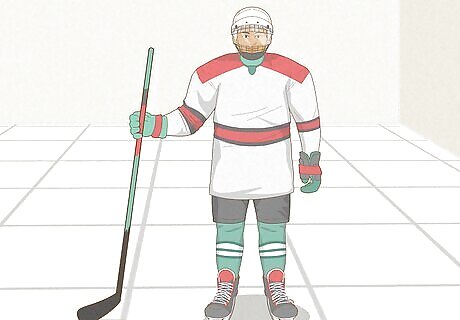
Grab your stick and test your equipment. Stand up, walk around for a bit, and flex until you’re sure you feel comfortable. You might catch something you missed when you were putting the pieces on one at a time. Once you’re satisfied, get your hockey stick and hit the ice! You won’t have time to get a good hockey stick before a game, so size it when you buy it. When a stick is the right size for you, it spans from your chin to the ice while you’re standing in your skates.












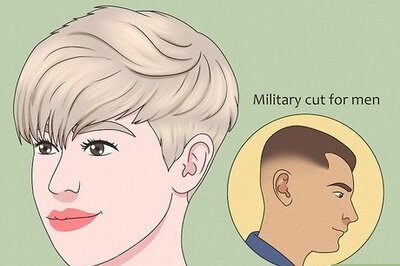





Comments
0 comment